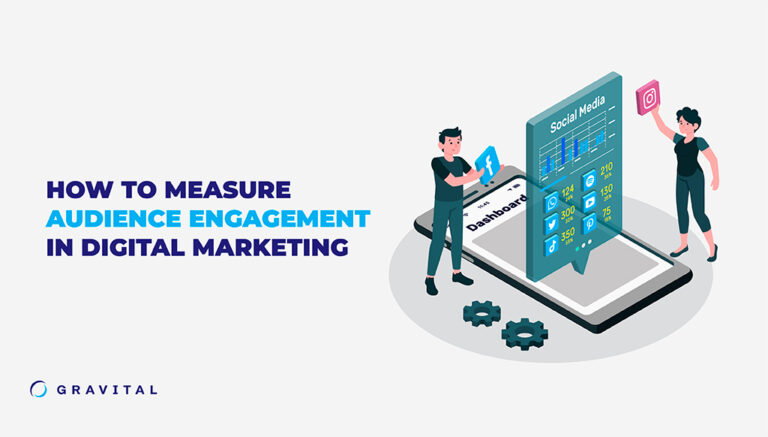Audience engagement is a must for the success of any digital marketing campaign, but how do you measure it? How do you know you’re actually engaging your target audience?
Engaged audiences–those actively involved with your online content–are more likely to become customers.
Audience engagement can be measured as time spent on your website, the number of pages they view, bounce rates and conversion rates, among other metrics. Following are 10 ways to measure and track your audience engagement.
Related Content: 10 Proven Ways to Engage Your Audience With Digital Marketing
The 10 Most Important Audience Engagement Metrics
1. Visit/Session Duration
This metric provides information about how much time visitors spend on your website. The longer they spend on your website, the more they’re engaged by your content. Visit or session duration can be measured in two ways: time spent on a specific webpage or the overall time spent on the website.
The drawback of this metric is that when someone leaves the tab for a website open without being active, it still counts as a session. For additional insight, consider engaged time, a metric that captures data–such as clicks on website elements and scroll positions–that show someone is actually paying attention and/or interacting with your content.
2. Number of Pages Per Session
The more pages users visit during a session, the higher their engagement level. The number of unique pages visited during a session implies that a user visited your website, navigated the website, landed on various pages, and read content before eventually leaving.
3. Page Views
Page views measure how often people visit certain pages of your website. A high number of page views could indicate a strong SEO (search engine optimization) strategy, high viewer interest or, on the other hand, visitors’ inability to find what they’re looking for. To determine the meaning of your page views, compare it to other audience engagement metrics.
4. Unique Visitors
Unique visitors refers to people who visit a website at least once during a specific period of time. Although Google puts more emphasis on tracking page views, the unique visitors metric shows how many individuals your website actually reaches.
To track unique visitors, Google Analytics assigns each visitor a client ID that is stored in the person’s browser. Because the client ID is unique to every browser, if a user visits a website using another browser, Google Analytics recognizes that visitor as another unique user. By the same token, multiple people sharing one computer and one browser count as one unique visitor.
5. New vs. Returning Visitors
New visitors are people who are visiting your website for the first time on a specific device. Returning visitors are those who have previously visited your website within the last two years. A high number of returning visitors can show audience engagement and loyalty, while a high number of new visitors may show an effective SEO strategy or a need to focus on getting previous visitors to come back.
Google Analytics uses client IDs stored in the browsers to track new and returning visitors. When you use two different devices to access the same website (for the first time in each device), each visit counts as a new visitor unless you’re signed-in on Google Chrome. In that case, the visit on the first device is new, and the one on the second device counts as a returning visit.
6. Conversion Rate
Conversion rate refers to the percentage of website viewers that complete specific actions such as purchasing a product or service, downloading an app or premium content or contacting your company via an online form. A high conversion rate indicates that your website’s content is engaging and that your digital marketing tactics are working.
This metric can be tailored to measure a variety of conversion rates, including overall conversion rate, marketing channel conversion rate and keyword conversion rate. Most social media platforms have built-in analytics tools that you can use to track your conversion rates.
7. Bounce Rate
The bounce rate is the percentage of website visitors that leave the website, or bounce off, after viewing only one page. This metric is inversely proportional to the average session duration, that is, as the bounce rate increases, the average session duration decreases. Therefore, a low bounce rate shows higher audience engagement.
Your website’s bounce rate helps you determine how engaging, or unengaging, your content is. If visitors are leaving your website without taking action, your content isn’t doing its job.
8. Top Exit Pages and Exit Rates
An exit page is the last page a visitor accessed before leaving a website. The exit rate measures the percentage of people that leave your website from that exit page. Identifying the top exit pages helps you make sense of your exit rate.
Some pages are designed to be the last page users visit on your website, such as a contact page. A high exit rate on those pages may indicate that visitors have completed a desired action. High exit rates on non-exit pages typically are caused by poorly organized information on your website (hierarchical issues), too much information, not enough information and missing calls to action.
9. Page/Scroll Depth
Page or scroll depth measures how thoroughly your audience consumes your content by tracking how far they scroll on a page. This metric offers two insights: readability and interest. When content is easy to read or interesting, people scroll further down the page in order to consume more content.
10. Social Shares
Social shares refer to when people share your content with their audience on social media, thus showing how engaging and appealing your content is. Social shares indicate higher audience engagement than likes and comments.
Wrapping It Up
The audience engagement metrics you should use depend on your type of business, target audience and other specific needs, but these 10 key metrics can get you started. For more information about how to measure your audience engagement, call us at 787-424-4443 or Talk to Us via our online contact form.


